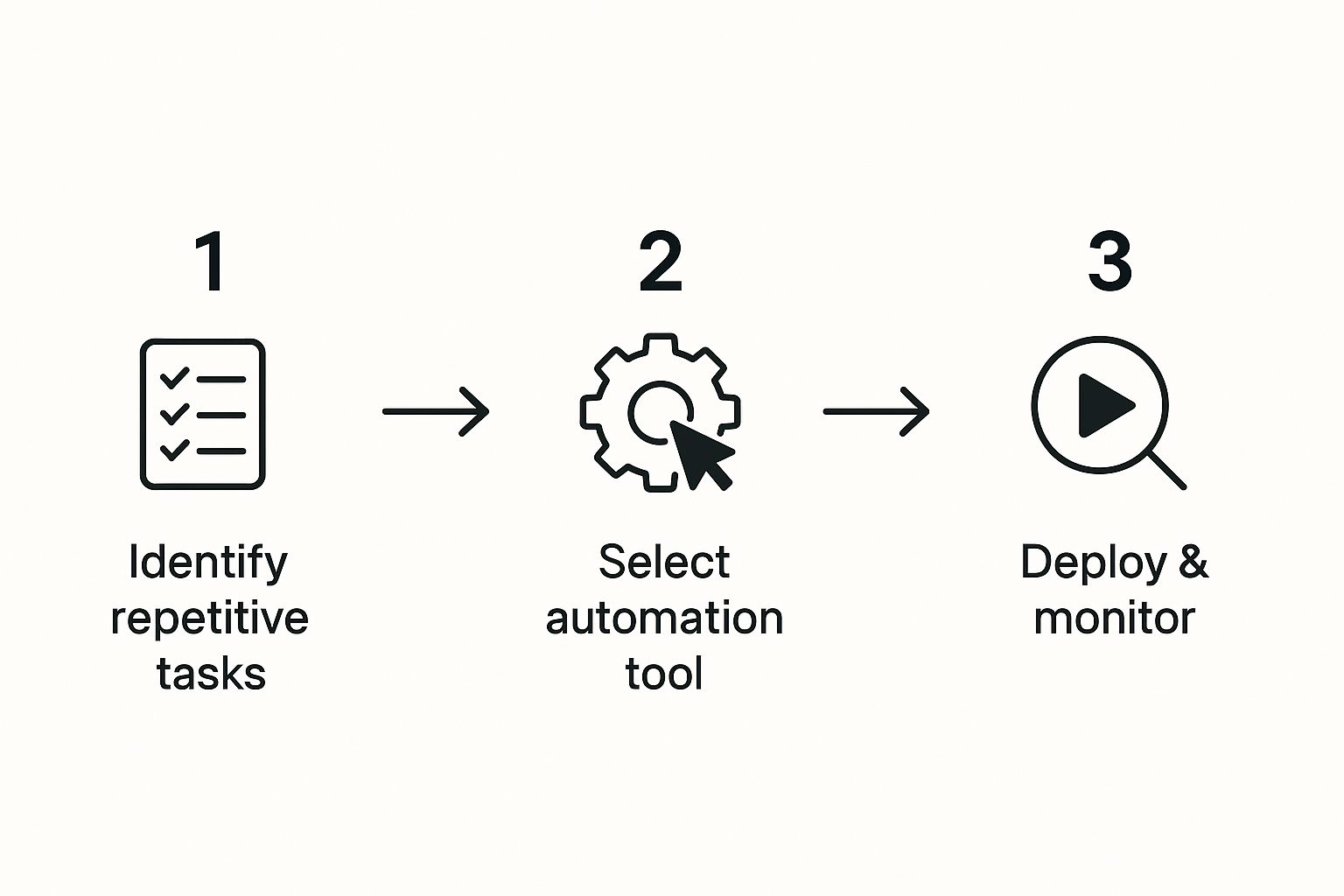A Founder's Guide to Task Automation
A practical guide to task automation for startup founders. Learn to implement AI-driven workflows that boost efficiency, reduce costs, and accelerate growth.
Task automation isn't just about sophisticated software; it's a strategic framework for survival. It involves configuring your technology to manage repetitive digital tasks autonomously, freeing up your team's most valuable resource: their attention.
For a founder, this is the key to reclaiming time. It reduces operational drag and empowers your team to focus on innovation, sales, and growth—not administrative overhead. Think of it as a force multiplier, enabling a lean startup to operate with the efficiency of a much larger organization and compete effectively.
Why Task automation Is a Founder's Secret Weapon

As a founder, your most critical asset isn't capital—it's your time and your team's cognitive bandwidth. Every minute spent manually entering data into a CRM, chasing follow-up emails, or compiling a weekly report is a minute not spent engaging with a customer or refining your product strategy.
This constant context-switching is a significant productivity drain. Psychologists refer to the cognitive cost of switching between tasks as an "attention residue" effect, which can reduce cognitive performance by up to 40%. For a startup, this friction grinds momentum to a halt.
Task automation is the most effective lever for combating this friction. It's not about replacing people; it's about amplifying their impact. By offloading monotonous work, you free up your team to tackle the complex, creative problems that drive business growth.
Escaping the Administrative Quicksand
For a rapidly scaling startup, administrative overload is like quicksand. It emerges subtly as your company grows, manifesting as disorganized workflows, missed deadlines, and lost opportunities. Implementing automation early allows you to build scalable systems from the outset, rather than attempting to repair broken processes later.
The impact on productivity is scientifically validated. A study published in the Harvard Business Review found that knowledge workers can save up to 20% of their time by automating repetitive tasks. Data from Vena Solutions shows that companies often see operating costs drop by an average of 22%. The payback is tangible, with firms reporting an ROI between 30% and 200% within the first year.
For a lean team, every automated process is like hiring a digital employee who works 24/7 without error. It’s your secret weapon for scaling operations faster than your headcount.
Before we explore implementation, let's examine the practical difference this makes.
Manual vs. Automated Startup Tasks: A Quick Comparison
This table illustrates the stark contrast between manual, high-friction processes and an automated, high-velocity approach. The shift is from being bogged down in repetitive tasks to creating streamlined, scalable operations that support growth.
| Startup Activity | The Manual Way (High Friction) | The Automated Way (High Velocity) |
|---|---|---|
| New Lead Follow-Up | A sales rep manually emails each lead, logs the interaction in a spreadsheet, and sets a reminder. | A new lead from a web form instantly triggers a welcome email, creates a CRM record, and assigns a follow-up task. |
| Social Media Posting | A marketing manager logs into multiple platforms daily to publish content. | A single tool schedules and publishes content across all platforms based on a pre-set calendar. |
| Customer Onboarding | A team member sends a series of welcome emails by hand over the first week. | A sequenced email campaign is automatically triggered when a new user signs up, guiding them through key features. |
| Weekly Reporting | An employee spends hours every Friday pulling data from disparate sources into a single report. | A dashboard automatically aggregates live data from all sources, updating the report in real-time. |
As demonstrated, the automated approach not only saves time but also improves consistency, reduces human error, and allows your team to operate at a higher strategic level.
A Competitive Advantage in Disguise
Ultimately, intelligent automation provides a significant competitive edge. It allows you to run with the efficiency of a much larger company while retaining the agility inherent to a startup.
This extends beyond internal processes. Automation can be a core component of your growth engine, particularly in areas like customer retention automation. By systemizing key processes, you lay a foundation for growth that doesn't fracture as you scale. For more strategies on enhancing team performance, our guide on how to be more productive offers frameworks that pair perfectly with automation.
Finding Your First High-Impact Automation Wins
Initiating an automation strategy can feel overwhelming. The key is to ignore the noise about complex, enterprise-level systems and focus on small, high-impact wins.
Begin with a simple 'process audit.' Observe your team's daily activities to identify low-hanging fruit—the tasks that are repetitive, rule-based, and consume significant time and mental energy.
Identify the Mind-Numbing, Rule-Based Stuff
Your initial targets should be tasks that require minimal complex decision-making. If the steps can be documented in a simple "if this, then that" format, it's an ideal candidate for automation.
Look for these patterns across your teams:
- Sales: Copy-pasting call notes into your CRM; sending the same follow-up email sequence repeatedly; manually assigning new leads from a spreadsheet.
- Marketing: Transferring lead information from a web form into a database; posting the same update to multiple social media platforms individually; tagging new email subscribers by hand.
- Operations: Sending Slack reminders for weekly status updates; generating the same report from the same data source every Monday; guiding new hires through a manual setup checklist.
These tasks are necessary but deliver low strategic value. Automating them provides an immediate return in reclaimed time.
Don't attempt to build a perfect, all-encompassing system initially. Your primary goal is to achieve a quick, tangible victory. Identify one task that, once automated, demonstrates the power of this approach and builds momentum.
Prioritize by Impact and Effort
After compiling a list of potential tasks, rank them using an impact/effort matrix. The ideal first automation is always high-impact and low-effort.
A classic example is lead qualification. A salesperson might currently be sifting through every form submission. Instead, an automation can instantly filter leads based on predefined criteria (e.g., company size, industry) and flag only qualified prospects for human follow-up. This single action can save hours each week, improve response times, and allow your sales team to focus on closing deals.
Another quick win is basic customer onboarding. A simple, automated email sequence triggered by a new signup can guide users through critical first steps, reducing support tickets without manual intervention.
The data underscores the urgency. According to Zapier, an estimated 94% of small businesses still perform repetitive tasks manually. However, the benefits of change are clear: a study they conducted found 66% of employees credit automation with direct boosts in productivity. You can dive deeper into the workflow automation statistics and trends to see the full picture. By starting small, you create immediate value and build the momentum needed for a more efficient future.
Building a Lean Startup Automation Stack

Selecting your first task automation tools requires a specific blend of power, affordability, and flexibility suited for a founder's needs. Building a lean stack isn't about acquiring the most expensive software; it's about choosing the right tools for your current stage.
Your immediate goal is a core set of tools that handle essential functions without requiring a dedicated engineer. Forget enterprise-level complexity. Your stack must be nimble, scalable, and intuitive enough for your entire team to adopt.
This means prioritizing tools that integrate seamlessly with your existing software ecosystem—such as Slack, Notion, and your CRM. A tool that cannot communicate with your current systems creates another data silo, defeating the purpose of automation.
Integrators vs. Specialists: The Core Debate
Your first major decision is choosing between integrator platforms and specialized tools. Each serves a distinct role in a lean startup's automation strategy.
-
Integrators (like Zapier or Make): These are the central nervous system of your automation stack, connecting disparate applications and enabling them to trigger actions in one another. They are ideal for cross-functional workflows, such as automatically adding a new Stripe customer to your email marketing list and sending a welcome message in Slack.
-
Specialized Tools: These platforms excel in one specific domain, such as marketing (HubSpot, ActiveCampaign) or sales (Salesloft). They offer a depth of functionality for specific use cases—like managing complex email nurture sequences or a high-touch sales cadence—that broad integrators cannot match.
For most startups, the optimal solution involves both. Begin with a powerful integrator to connect your core business applications. Then, layer in specialized tools as specific departments mature and encounter clear, recurring pain points that a specialist tool can solve more effectively. This approach maximizes flexibility without overwhelming your team or budget.
The best automation stack is one that grows with you. Start with a simple, powerful integrator to connect your essential tools. Don't over-invest in specialized software until you have a clear, recurring pain point that it solves better than anything else.
Startup Automation Tool-Type Selector
To aid your decision-making, here is a framework for selecting tools based on your team's current needs and technical capabilities.
| Tool Category | Best For | Example Tools | Founder-Friendly Score (1-5) |
|---|---|---|---|
| No-Code Integrators | Connecting disparate apps with zero engineering overhead. Great for first-time founders. | Zapier, Make, n8n | 5 |
| Specialized Sales Tools | Automating outreach, follow-ups, and lead nurturing for small sales teams. | Salesloft, Outreach, Apollo.io | 4 |
| Marketing Platforms | Managing complex email campaigns, user journeys, and lead scoring. | HubSpot, ActiveCampaign, Customer.io | 4 |
| Low-Code Platforms | Building custom internal tools with minimal coding for ops-heavy businesses. | Retool, Appsmith | 3 |
Choosing the right tool is a balancing act. For startups building a lean technical foundation, even understanding how to begin automating infrastructure with Terraform is a valuable step toward greater efficiency.
Automating Your Sprint with AI Intelligence
Basic task automation reclaims time. AI-powered automation generates intelligence. This represents a leap from simple "if this, then that" rules to a system that can learn, predict, and assist your team in real time. For a founder, this provides a high-fidelity view of your sprint's health without requiring constant meetings or micromanagement.
The objective is to create a self-updating workflow that translates daily progress reports into actionable insights. Instead of manually chasing status updates, the system parses daily check-ins, updates project boards, flags roadblocks, and even drafts sprint summaries.
This infographic outlines the fundamental process for launching any automation, and it applies perfectly to more advanced AI workflows.

This simple flow—identify, select, deploy—is the blueprint. It works for both simple notifications and complex AI-driven reports. Start small to build momentum.
Connecting Daily Inputs to Project Momentum
The first step is to connect the firehose of daily communication to your system of record. Most startup teams operate in a chat tool like Slack, while the project plan resides elsewhere—in Asana, Jira, or Notion. Your goal is to bridge this gap intelligently.
You can configure an automation to monitor a specific Slack channel where the team posts daily updates. From there, a large language model (LLM) can parse these natural language updates to extract key information.
- Task Progress: It can identify task IDs (e.g., "Made progress on TIX-123") and automatically move that ticket on your project board from 'In Progress' to 'In Review'. This eliminates manual updates.
- Blocker Detection: The AI can recognize keywords like "stuck," "blocked," or "waiting on." When detected, it can automatically flag the task, notify the project lead, and create a high-priority item for the next stand-up meeting.
- Effort Analysis: Over time, the AI can analyze the language in updates to gauge sentiment or perceived effort, providing a qualitative layer of insight into team morale and project difficulty.
Tools like Zapier now offer direct integrations with AI models from providers like OpenAI, making it possible to build these intelligent workflows without writing code.

This represents a toolkit for injecting advanced reasoning and language processing directly into your existing applications.
From Raw Data to Sprint Summaries
Once this data connection is established, you can move beyond simple ticket updates. You are now building a structured repository of all sprint activities, which is ideal for AI analysis.
At the end of a sprint, another automation can feed all daily updates from the past week into an AI model and request a draft summary report.
Your prompt could be: "Based on all daily updates from the past week, draft a sprint summary. Highlight key accomplishments, identify any tasks flagged as blocked, and list the team members who shipped each major feature."
A process that previously took hours of manual compilation becomes a five-minute review-and-edit task. This is a powerful example of task automation that not only saves time but also produces a more accurate and comprehensive overview of the sprint.
Research indicates that AI's ability to handle complex, multi-step tasks is growing exponentially, doubling roughly every 7 months. By implementing these systems now, you position your team to leverage this rapid technological advancement.
Scaling Automation as Your Team Grows

As your initial automations prove their value, you'll reach an inflection point where task automation evolves from a series of side projects into a core part of your company's operating system.
To make this transition, you must think beyond simply adding more workflows. The goal is to build a sustainable and scalable system. This means treating your automations with the same rigor as any other piece of critical infrastructure.
Document every automation thoroughly. A short screen recording or a simple Notion page is non-negotiable. Explain its function, the applications it interacts with, and the protocol for when it fails. Undocumented automations are technical debt and become a significant liability when key personnel leave.
Sidestepping Common Automation Pitfalls
As you become more ambitious, two common traps emerge. The first is creating "brittle" automations—overly complex systems that break when an API or process is slightly modified.
The second pitfall is more dangerous: automating a flawed process. Automation is an accelerator. If your manual process is inefficient, automating it will only help you make the same mistakes faster and at a greater scale.
Before automating any process, ask one simple question: "Is this process as lean and effective as it can possibly be?" Optimize first, then automate. A clean manual process is always superior to a clunky automated one.
The best practice is to build modular, single-purpose automations. Instead of one large workflow handling ten different functions, create several smaller, focused automations that can be chained together. These are easier to debug, update, and adapt as your startup evolves.
Building an Automation-First Culture
True scalability comes from empowering every team member to identify and solve inefficiencies, not from a single engineer building everything. This isn't about turning your marketing lead into a developer; it's about fostering a mindset where people constantly ask, "Could this be automated?"
Provide your team with the tools and encouragement to spot their own repetitive tasks and build simple solutions. When efficiency becomes a shared responsibility, you embed task automation deep into your company culture and create distributed ownership.
Consider marketing automation as a model. As of 2024, 58% of marketing leaders have automated their email workflows, with the global market projected to reach $14.55 billion by 2031. You can see more compelling automation statistics from Vena Solutions.
Creating this culture requires clear, shared objectives. For a solid framework on aligning your team, review our guide on how to set goals effectively—it's an ideal complement to a company-wide automation initiative.
Founder FAQ on Task Automation
Even with a clear strategy, founders often face recurring questions about implementation, team adoption, and potential pitfalls. Here are direct answers to the most common concerns.
What's the Biggest Mistake Startups Make with Task Automation?
The most common and costly mistake is automating a broken or inefficient manual process.
Founders, driven by the promise of efficiency, often rush to automate a workflow without first analyzing its effectiveness. Automation only amplifies the underlying process. It’s like putting a rocket engine on a broken car—you will simply crash more spectacularly.
Before using any automation tool, map out the current process. Use a whiteboard, talk to your team, and identify points of friction. Can certain steps be eliminated? Can the entire workflow be simplified?
Always optimize the process before you automate it. Automating a clean, streamlined workflow delivers exponential results. Automating a convoluted one solidifies chaos.
How Do I Get My Non-Technical Team Members to Adopt This Stuff?
The key is to frame it around their individual benefit, not abstract company goals. Vague concepts like "improving company-wide efficiency" are less compelling than solving a tangible, daily annoyance.
Start by identifying one tedious, universally disliked task within a specific team—for instance, the manual copying of customer feedback from emails into a project management tool.
Build a simple automation to solve that single pain point. Then, demonstrate the time they have reclaimed. When individuals see a direct, personal benefit to their workload, they become powerful advocates for the technology.
Once you solve one person's biggest headache with automation, they'll start looking for other headaches to solve. This creates a natural, bottom-up adoption that feels helpful, not forced.
From there, foster this momentum. Encourage team members to identify other repetitive tasks and provide them with user-friendly tools. The goal is not to turn everyone into an engineer, but to empower them to think critically about their work and spot opportunities for improvement.
When Is It Too Early for a Startup to Start Automating?
It is almost never too early, but the type of automation you choose is critical.
A two-person startup likely does not need a complex, multi-step marketing sequence that costs hundreds of dollars per month. This is premature optimization—investing in capabilities that exceed current needs.
However, that same two-person team can derive significant value from automating simple, high-frequency tasks. Consider small, repetitive actions:
- Welcome Emails: Automatically sending a welcome message the moment a new user signs up.
- Contact Forms: Piping new submissions from your website directly into a dedicated Slack channel to ensure no lead is missed.
- Calendar Invites: Turning email requests into calendar events with one click to eliminate manual scheduling.
A practical rule of thumb is: if you find yourself performing the exact same digital task more than five times a week, it is a prime candidate for automation, regardless of your company's size. Start there to accumulate small, consistent wins.
Sprint Smarter. Forecast Every Week.
Log wins. Build momentum. Let AI show you if you're on track to hit your sprint goal—before it's too late.
Join the waitlist and be the first to unlock predictive clarity for your team.

